Good ideas usually have system-like characteristics. That may seem strange, considering how we have been indoctrinated all our lives to believe great ideas are simple, complete and self-evident once conceived (think solutions to problems or opportunities for enrichment). Examples of these abound, many now urban legends. Some of the best known are the “bottle it” idea offered to Coca Cola, the change of green to white in the Lucky Strike cigarette package as “Lucky Strike green went to war”, the fresh eggs added to cake mixes in the 50’s to convince homemakers that they were still responsible cooks, the plain pencil used by Soviet cosmonauts in contrast to the multi-million dollar space pen bought by NASA for American astronauts, and Post-its, the 3-M product made with a glue overlooked because it wouldn’t permanently stick.
Great solutions really can begin with “a-ha” revelations. Post-it notes were the result of 3M researcher Art Fry’s need in 1974 to create book marks for his hymnal that wouldn’t fall out when he was singing with the choir. He remembered an unusual glue created six years earlier by a fellow researcher. While interesting structurally, it stuck only slightly and was easily peelable. Fry saw its usefulness in its ability not to stick well, and it became the basis for a major 3M product success. The a-ha was crucial, but success ultimately required rethinking office needs and creating a system solution of temporary stick-ons useful across the range of business processes.
Others of the instant solution genera were more “wish it were so” than inspirational history. The “bottle it” story — that a stranger offered for $100 (or other figures up to $100,000 depending on the story version) to show how Coca Cola could make a fortune (bottling it) — never happened. Bottling in the 1880’s was a chancy business, difficult, expensive and subject to serious health risks from unsanitary bottle cleaning, filling and stoppering. Asa Candler, the owner of Coca Cola, knew about bottling, knew about the risks and expense, and did not think bottling viable in the early years of the company. Coca Cola did become bottled — in the 1890’s — but only when the company was wealthier and a safe, systematic (and expensive) bottling process could be developed.
A graphic design success story with supposed instant genesis is the World War II change of the Lucky Strike cigarette package color from olive green with a red bull’s eye and black lettering to white with the same red bull’s eye and lettering. The story was that, with all the need for olive green paint and dye for the war effort, Lucky Strike would give up its green for the duration. Hence, “Lucky Strike green has gone to war” and instant appeal to patriotism among the smoking public. Actually, marketing research had shown women did not like the green color and men were beginning to reject it also… The white color was a cleaner look, more representatives of the graphics coming out of the modern movement. The real basis for the idea was thoughtful analysis of user behavior.
In the late 1950’s, major food companies who had introduced instant, complete cake mixes (only requiring the addition of water) saw their sales flattening. Marketing research in this case suggested that women felt guilty about baking cakes that required them only to add water. Their minimal participation did not measure up to what they had been taught as they grew up. Marketing research consultant Ernest Dichter suggested that, instead of including dried eggs in the mix, companies should ask homemakers to add fresh eggs. Sales climbed back, but was it the eggs? Actually, General Mills opted to go with the fresh-egg idea, but Pillsbury continued with complete mixes. Both enjoyed success! A more likely answer was the transfer of emphasis from cake baking to finishing with frosting, layering and decoration. The perception that the problem was the level of involvement was right, but the solution was more a system solution of total cake creation.
The more recent example of marking instruments in space seems to suggest that good common sense often obviates the need for complex solutions. The truth in the space pen project is that both Soviets and Americans used pencils in the early years of space exploration. In 1965, Paul C. Fisher, a pen manufacturer, saw the need for a space-usable pen because pencil leads loose in space are dangerous to eyes and breathing, and both pencil wood and lead are highly flammable in a 100% oxygen environment. His company developed a pressurized, fireproof ball-point pen that uses an ink safe below 200 degrees Celsius. Since 1968, both American astronauts and Russian cosmonauts have used Fisher pens. Fisher charged nothing for development and sold pens to NASA in 1967 for $2.95 apiece.
Along with Post-its, where the urban legend is true, these stories, when investigated, actually corroborate the idea that good solutions are usually much more than simple ideas. They may start out simply — seemingly complete and elegant in their simplicity — but they are really still “glimmers” of ideas that, in the end, achieve their strength through the work required to make them holistic and multifunctional.
The Nature of Synthesis
From the Greek, “to put together”, synthesis is a good word to cover what goes on as ideas are expanded from glimmers to what is necessary to solve a problem or take advantage of an opportunity. The synthesis process is one of composition or combination of parts or elements to form a whole.
Synthesis is not invention — except as invention may be included incidentally or intentionally for special problem considerations. Most solutions to problems combine things well known in new patterns or compositions appropriate to a new situation or opportunity. Invention’s role in synthesis is providing components of the solution not already available and enabling available components to achieve better fit through innovative modification of their characteristics.
Where does invention occur overall? In most development processes, formal or informal, invention is a part of the process from the beginning. At early stages of a project, it may come as creation of policy when broad directions for a solution are formulated. As information is developed and analyzed, it may come as specific ideas in response to insights. At the synthesis stage, when ideas are finally assembled and refined into compound, system solutions, it comes as the infill necessary to complete a mosaic of existing component ideas and modifications of existing ideas.
The Synthesis Process
In Structured Planning, Synthesis has a phase all to itself. In this article, I will consider synthesis from that special perspective because tools developed in the evolution of Structured Planning uniquely support the synthesis process.
Synthesis implies assembly, and the parts and tools needed include candidate ideas for consolidation (these may well include glimmers of ideas that have set the whole development process in motion), some kind of road map for the composition process, and insights for what to watch out for, what to improve, and what good things to incorporate almost “as is” in the final solution.
In previous articles, I introduced some of these elements in the process of discussing how insights are gained and used (Insight and Ideas), how ideas are focused and articulated (Capturing Ideas), and how structuring is applied (Using the Tools of Structure and Organizing for Innovation). For a Structured Planning team, products of each of these processes are already available for use in the Synthesis phase: Design Factor documents, Solution Element documents, and an Information Structure.
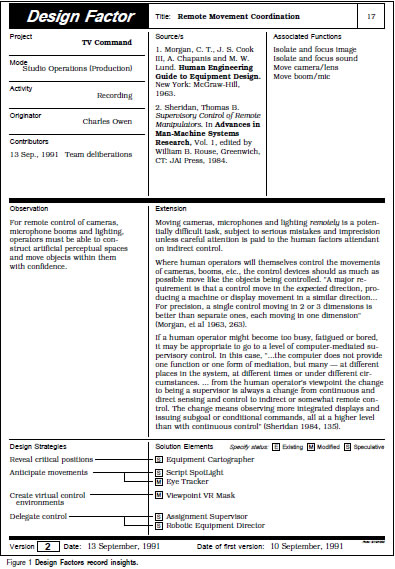 Figure 1
Figure 1
Design Factors (see Figure 1) are one-page documents recording insights gained during the study of users and required system functionality. Solution Elements (Figure 2) are one-page documents describing ideas developed from the insights or otherwise attained during the project.
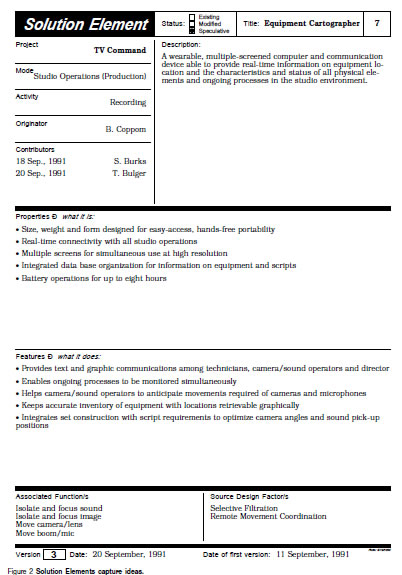
Figure 2
An Information Structure (Figure 3) is a hierarchical organization of the Functions expected to be performed by the system under design.
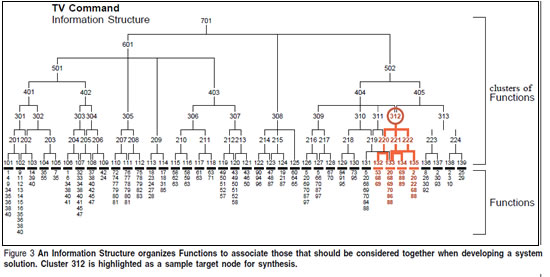 Figure 3
Figure 3
The Functions are organized by scoring the Solution Elements (usually hundreds) against them and measuring the degree to which pairs of Functions are in a condition of common support by Solution Elements or are in a condition of support for one and obstruction for the other — both of which reasons they should be considered together. Functions so associated are linked to form a network, or graph. The graph is then decomposed to identify clusters of highly-linked Functions, and the clusters are re-composed into a hierarchical Information Structure, an optimal tool for directing synthesis (see The Power of Abstraction).
Using the Information Structure as the road map, a Structured Planning team synthesizes system solutions using a method called Ends/Means Synthesis. This method can be used very effectively anywhere as a structured form of brainstorming, but it is particularly effective in the Synthesis phase of Structured Planning because of the support materials, already accumulated, that can be used with it.
Ends/Means Synthesis
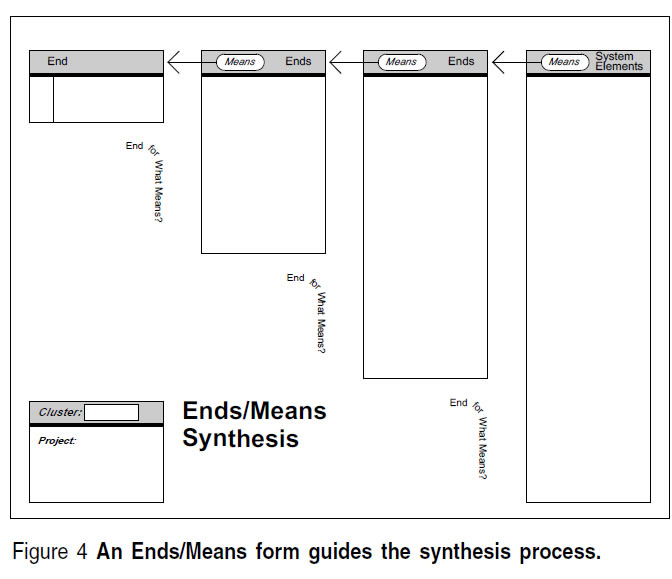
Figure 4
Figure 4 shows a form used in Ends/Means Synthesis. The form itself isn’t actually necessary, but its graphic structure provides direction for an individual or group new to the method. On the left, is a box in which to write a high-level goal as an “end” to be achieved. In Structured Planning, it is a node within the Information Structure (for example, the node 312 circled in Figure 3). Progressing to the right are, first, a longer box to contain “means”, and then still longer boxes to contain new means and new ends.
When the process is used by a team (Figure 5),
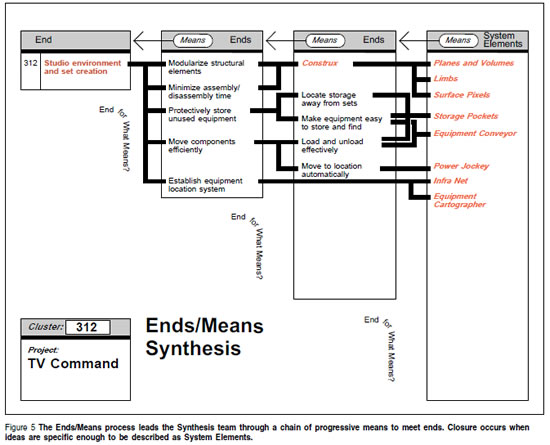 Figure 5
Figure 5
the team leader begins a session by asking, “What means do we need to achieve this end?”, pointing to the goal at the left. Team members respond, and the team leader enters their ideas as verb phrases in the box just to the right of the end” goal. When the means that have been generated together cover the goal additively (and’s not or’s — or’s would introduce alternatives and unacceptable complication), the team leader moves to the first of the means, and announces it as a new end for which new means need to be generated. The process then continues in the next box to the right, entering new means — now noticeably more specific — for each new end.
Over three or four cycles, means become specific enough to become describable components of a system solution. As the process approaches this level of detail, the benefits of Structured Planning begin to kick in full. Solution Elements associated with Functions in the target node of the Information Structure become candidate final System Elements. Design Factor insights focus attention on potential problems and opportunities in this part of the Information Structure that should be taken into consideration. Finally, the Functions themselves become criteria to judge the solutions — every Function must be satisfied by one or more features of the System Elements for the system solution to be successful.
The result, after applying the process progressively to nodes across the entire Information Structure, is a holistic system synthesized from existing, modified and invented component concepts.

















